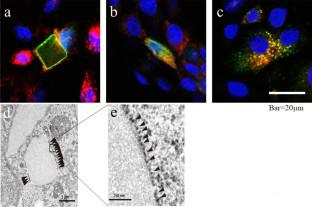Glycoconjugate Journal ( IF 3 ) Pub Date : 2023-12-26 , DOI: 10.1007/s10719-023-10135-6 Kohji Itoh , Jun Tsukimoto

|
Neuraminidase 1 (NEU1) is a lysosomal sialidase that cleaves terminal α-linked sialic acid residues from sialylglycans. NEU1 is biosynthesized in the rough endoplasmic reticulum (RER) lumen as an N-glycosylated protein to associate with its protective protein/cathepsin A (CTSA) and then form a lysosomal multienzyme complex (LMC) also containing β-galactosidase 1 (GLB1). Unlike other mammalian sialidases, including NEU2 to NEU4, NEU1 transport to lysosomes requires association of NEU1 with CTSA, binding of the CTSA carrying terminal mannose 6-phosphate (M6P)-type N-glycan with M6P receptor (M6PR), and intralysosomal NEU1 activation at acidic pH. In contrast, overexpression of the single NEU1 gene in mammalian cells causes intracellular NEU1 protein crystallization in the RER due to self-aggregation when intracellular CTSA is reduced to a relatively low level. Sialidosis (SiD) and galactosialidosis (GS) are autosomal recessive lysosomal storage diseases caused by the gene mutations of NEU1 and CTSA, respectively. These incurable diseases associate with the NEU1 deficiency, excessive accumulation of sialylglycans in neurovisceral organs, and systemic manifestations. We established a novel GS model mouse carrying homozygotic Ctsa IVS6 + 1 g/a mutation causing partial exon 6 skipping with simultaneous deficiency of Ctsa and Neu1. Symptoms developed in the GS mice like those in juvenile/adult GS patients, such as myoclonic seizures, suppressed behavior, gargoyle-like face, edema, proctoptosis due to Neu1 deficiency, and sialylglycan accumulation associated with neurovisceral inflammation. We developed a modified NEU1 (modNEU1), which does not form protein crystals but is transported to lysosomes by co-expressed CTSA. In vivo gene therapy for GS and SiD utilizing a single adeno-associated virus (AAV) carrying modNEU1 and CTSA genes under dual promoter control will be created.
中文翻译:

溶酶体唾液酸酶 NEU1、其细胞内特性、缺陷以及作为治疗剂的用途
神经氨酸酶 1 (NEU1) 是一种溶酶体唾液酸酶,可从唾液酸聚糖中裂解末端 α-连接的唾液酸残基。NEU1 在粗面内质网 (RER) 腔中生物合成为 N-糖基化蛋白,与其保护蛋白/组织蛋白酶 A (CTSA) 结合,然后形成还含有 β-半乳糖苷酶 1 (GLB1) 的溶酶体多酶复合物 (LMC)。与其他哺乳动物唾液酸酶(包括 NEU2 到 NEU4)不同,NEU1 转运至溶酶体需要 NEU1 与 CTSA 结合,携带末端甘露糖 6-磷酸 (M6P) 型 N-聚糖的 CTSA 与 M6P 受体 (M6PR) 结合,以及溶酶体内 NEU1 激活在酸性pH值下。相反,当细胞内CTSA降低到相对较低的水平时,哺乳动物细胞中单个NEU1基因的过度表达会导致细胞内NEU1蛋白由于自我聚集而在RER中结晶。唾液酸贮积症(SiD)和半乳糖唾液酸贮积症(GS)是分别由NEU1和CTSA基因突变引起的常染色体隐性溶酶体贮积病。这些疑难杂症与NEU1缺乏、唾液酸聚糖在神经内脏器官中过度积累以及全身表现有关。我们建立了一种携带纯合Ctsa IVS6 + 1 g/a突变的新型 GS 模型小鼠,该突变导致部分外显子 6 跳跃,同时缺乏 Ctsa 和 Neu1。GS 小鼠出现的症状与青少年/成年 GS 患者相似,例如肌阵挛发作、行为抑制、石像鬼样面孔、水肿、Neu1 缺乏导致的脱肛以及与神经内脏炎症相关的唾液酸聚糖积聚。我们开发了一种修饰的 NEU1 (modNEU1),它不形成蛋白质晶体,而是通过共表达的 CTSA 转运到溶酶体。将创建利用在双启动子控制下携带modNEU1和CTSA基因的单一腺相关病毒 (AAV) 进行 GS 和 SiD 的体内基因治疗。



























 京公网安备 11010802027423号
京公网安备 11010802027423号